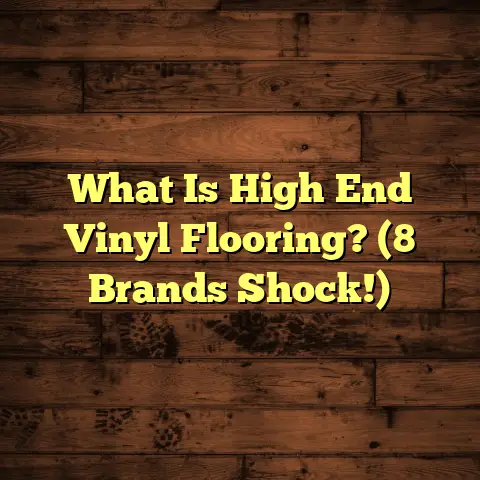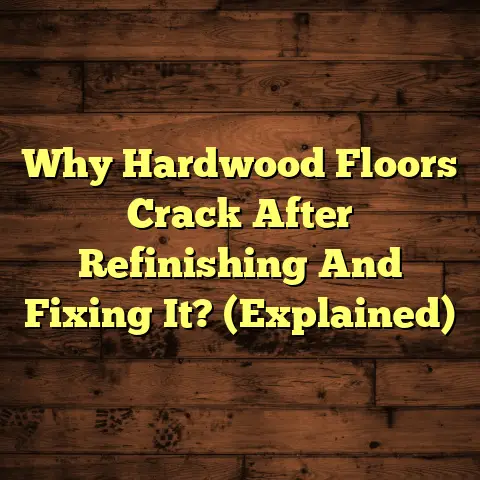Wood Floor Cleaner? (3 Solutions BANNED!)
It’s your friendly neighborhood flooring contractor here.
I’ve noticed a HUGE shift lately.
More and more folks are waking up to the importance of eco-friendly cleaning. And honestly?
It’s about time!
We all want beautiful wood floors, right? But at what cost?
We need to think about how we maintain them, not just for looks, but for the long haul.
And let’s be real – who wants to fill their home with harsh chemicals that could harm their family or the environment? Not me!
In this article, we’re diving deep into the world of wood floor cleaners. I’m going to expose some common solutions that are actually doing more harm than good.
And don’t worry, I won’t leave you hanging. I’ll also share some amazing, natural alternatives that will keep your floors sparkling and your conscience clear.
Section 1: Understanding Wood Floors
First things first, let’s talk wood.
Did you know there are different types of wood flooring, and each has its own personality?
-
Solid Hardwood: The real deal. These floors are made from a single piece of wood, like oak, maple, or walnut. They’re gorgeous and can last for generations if properly cared for.
-
Engineered Wood: Think of this as plywood, but with a beautiful veneer of real wood on top. It’s more stable than solid hardwood, especially in areas with high humidity.
-
Laminate: This is the budget- friendly option. It’s basically a photographic image of wood glued to a composite core. While it’s durable, it doesn’t have the same warmth or feel as real wood.
Now, why is this important when it comes to cleaning?
Because each type reacts differently to cleaning products!
Solid hardwood can be damaged by too much water, while laminate can be easily scratched by abrasive cleaners.
Using the WRONG cleaner can lead to:
- Dullness: Stripping away the finish, leaving your floors looking lifeless.
- Warping: Especially with solid hardwood, excessive moisture can cause the wood to swell and warp.
- Scratches: Abrasive cleaners can leave unsightly scratches, especially on laminate and engineered wood.
- Discoloration: Some chemicals can react with the wood, causing stains or discoloration.
Trust me, I’ve seen it all!
One of the most common issues I see is dirt buildup. Over time, dirt and grime can accumulate in the grooves and crevices of your wood floors, making them look dull and dirty.
Stains are another big problem.
Spills, pet accidents, and even just walking around with dirty shoes can leave unsightly stains that are difficult to remove.
And of course, there’s water damage.
Whether it’s from a leaky pipe, a spilled drink, or just mopping with too much water, water damage can cause serious problems, including warping, cupping, and even rot.
That’s why choosing the right cleaning product is absolutely crucial.
Section 2: The Dangers of Conventional Wood Floor Cleaners
Okay, let’s get to the juicy part.
I’m about to reveal three wood floor cleaning solutions that you should BAN from your home ASAP!
These are solutions that I used to recommend, that I saw used often, but that I just can’t stand by anymore.
-
Ammonia-Based Cleaners: These are often marketed as all-purpose cleaners, but they’re a big NO-NO for wood floors.
-
Oil Soap: Sounds gentle, right? WRONG! It can leave a dull, sticky residue that attracts dirt and makes your floors look even worse.
-
Vinegar (in high concentrations): I know what you’re thinking: “Vinegar? Isn’t that natural?”
Yes, but using it undiluted or in high concentrations can actually damage the finish on your wood floors.
Let’s break down why these solutions are so harmful.
Ammonia-Based Cleaners:
Ammonia is a powerful chemical that can strip away the finish on your wood floors, leaving them dull and vulnerable to damage.
It can also irritate your skin, eyes, and respiratory system.
According to the EPA, exposure to ammonia can cause coughing, shortness of breath, and even pulmonary edema (fluid in the lungs) in high concentrations.
Plus, ammonia is a known environmental pollutant.
Oil Soap:
Oil soap is designed to clean and condition wood, but it often leaves behind a greasy residue that attracts dirt and grime.
Over time, this residue can build up and make your floors look dull and dirty.
It can also make them slippery, which is a safety hazard, especially for children and the elderly.
I’ve seen floors that are so coated in oil soap residue that they are almost impossible to properly clean!
Vinegar (in high concentrations):
While vinegar is a natural cleaner, it’s also acidic.
Using it undiluted or in high concentrations can damage the finish on your wood floors, especially if they have a polyurethane coating.
The acid can eat away at the finish, leaving your floors looking dull and worn.
I’ve seen floors where people have used too much vinegar and the finish is literally gone in spots!
The short-term effects of exposure to these cleaners can include:
- Respiratory irritation: Coughing, wheezing, and shortness of breath.
- Skin irritation: Redness, itching, and burning.
- Eye irritation: Redness, watering, and blurred vision.
- Headaches: From inhaling the fumes.
The long-term effects can be even more serious:
- Asthma: Repeated exposure to irritating chemicals can trigger asthma attacks.
- Allergies: Some chemicals can cause allergic reactions, such as skin rashes or hives.
- Cancer: Some chemicals found in conventional cleaners have been linked to cancer in animal studies.
- Environmental damage: These chemicals can pollute our waterways and harm wildlife.
I think the risk is just not worth it. We can achieve the same results, or better, with alternatives that don’t carry those risks.
Section 3: Eco-Friendly Alternatives to Banned Cleaners
Alright, let’s talk about the good stuff!
I’m going to share three amazing eco- friendly wood floor cleaning solutions that are safe, effective, and won’t break the bank.
- Vinegar and Water (Properly Diluted!)
- Olive Oil and Essential Oils
- Commercial Eco-Friendly Cleaners
Solution 1: Vinegar and Water
Yes, I know I just bashed vinegar. But hear me out!
When used properly, vinegar can be a fantastic wood floor cleaner.
The key is dilution. You want to use a very mild solution of vinegar and water.
Here’s how to make it:
- Mix 1/2 cup of white vinegar with 1 gallon of warm water.
- Pour the solution into a spray bottle.
- Lightly mist your wood floors with the solution.
- Wipe with a clean, damp mop or microfiber cloth.
The science behind this solution is simple:
Vinegar is a mild acid that can help to break down dirt and grime.
It also has natural antibacterial properties, which can help to kill germs and bacteria on your floors.
The water helps to dilute the vinegar and prevent it from damaging the finish on your wood floors.
Pros:
- Inexpensive: Vinegar is super cheap and readily available.
- Effective: It’s great for removing dirt and grime.
- Natural: It’s a natural and non-toxic cleaner.
Cons:
- Smell: Some people don’t like the smell of vinegar. (Don’t worry, it dissipates quickly!)
- Can damage finish if not diluted: Using too much vinegar can damage the finish on your wood floors.
Important Note: Always test this solution in an inconspicuous area first to make sure it doesn’t damage your floors.
Solution 2: Olive Oil and Essential Oils
This is one of my favorite DIY wood floor cleaners.
It not only cleans your floors, but it also conditions them, leaving them looking shiny and healthy.
Here’s how to make it:
- Mix 1/4 cup of olive oil with 1/2 cup of white vinegar.
- Add 10-15 drops of your favorite essential oil (I like lemon, lavender, or tea tree).
- Pour the solution into a spray bottle.
- Lightly mist your wood floors with the solution.
- Wipe with a clean, damp mop or microfiber cloth.
The olive oil helps to moisturize the wood and prevent it from drying out, while the vinegar helps to clean and disinfect.
The essential oils add a pleasant scent and also have natural antibacterial properties.
For example, tea tree oil is known for its powerful antibacterial and antifungal properties.
Lemon oil is a natural degreaser and can help to remove stubborn stains.
Lavender oil has a calming scent and can help to create a relaxing atmosphere in your home.
Pros:
- Cleans and conditions: This solution cleans and conditions your wood floors in one step.
- Natural: It’s made with natural ingredients.
- Smells great: The essential oils add a pleasant scent to your home.
Cons:
- Can be a bit oily: Using too much olive oil can leave your floors feeling a bit oily.
- May not be suitable for all wood types: Test this solution in an inconspicuous area first to make sure it doesn’t damage your floors.
Solution 3: Commercial Eco-Friendly Cleaners
If you’re not into DIY, there are plenty of great eco-friendly wood floor cleaners on the market.
Look for brands that are certified by organizations like Green Seal or EPA Safer Choice.
These certifications mean that the product has been tested and verified to be safe for the environment and human health.
Some of my favorite brands include:
- Method: Their wood floor cleaner is plant-based and biodegradable.
- Better Life: Their floor cleaner is made with natural ingredients and is safe for pets and children.
- Mrs. Meyer’s Clean Day: Their multi-surface cleaner can be used on wood floors and is made with essential oils.
Pros:
- Convenient: These cleaners are ready to use right out of the bottle.
- Effective: They’re formulated to effectively clean wood floors.
- Safe: They’re made with safe and non-toxic ingredients.
Cons:
- Can be more expensive: Eco- friendly cleaners can be more expensive than conventional cleaners.
- May not be as readily available: Some eco-friendly cleaners may be harder to find in your local store.
When choosing a commercial eco- friendly cleaner, be sure to read the label carefully and follow the manufacturer’s instructions.
Section 4: How to Properly Clean Wood Floors
Now that you have your eco-friendly cleaning solution, let’s talk about how to properly clean your wood floors.
Here’s a step-by-step guide:
- Sweep or vacuum: Start by removing any loose dirt, dust, and debris from your floors.
- Prepare your cleaning solution: Mix your chosen eco-friendly cleaning solution according to the instructions.
- Lightly mist your floors: Spray a small amount of the cleaning solution onto your floors.
- Wipe with a clean, damp mop or microfiber cloth: Work in small sections, overlapping each stroke.
- Rinse your mop or cloth frequently: This will prevent you from spreading dirt and grime around.
- Dry your floors: Use a clean, dry towel or microfiber cloth to dry your floors. This will help to prevent water spots and streaks.
Regular Maintenance:
To keep your wood floors looking their best, it’s important to clean them regularly.
I recommend sweeping or vacuuming your floors at least once a week, and mopping them every 2-4 weeks, depending on how much traffic they get.
Tips and Tricks:
- Use the right mop: A microfiber mop is ideal for cleaning wood floors. It’s gentle on the finish and effectively removes dirt and grime.
- Don’t use too much water: Excessive water can damage wood floors. Be sure to wring out your mop or cloth thoroughly before wiping your floors.
- Avoid abrasive cleaners: Abrasive cleaners can scratch and damage the finish on your wood floors.
- Clean up spills immediately: Spills can stain and damage wood floors if left unattended.
- Use floor mats: Place floor mats at entrances to trap dirt and debris before they get tracked onto your wood floors.
Section 5: The Benefits of Switching to Eco-Friendly Cleaners
Okay, so we’ve covered the dangers of conventional cleaners and the benefits of eco-friendly alternatives.
But let’s really drive home why making the switch is so important.
Health Benefits:
Eco-friendly cleaners are made with safe and non-toxic ingredients, which means they’re less likely to cause respiratory irritation, skin irritation, or other health problems.
This is especially important for families with young children, pets, or people with allergies or asthma.
Environmental Impact:
Conventional cleaners often contain harmful chemicals that can pollute our waterways and harm wildlife.
Eco-friendly cleaners are made with biodegradable ingredients that break down quickly and don’t harm the environment.
Cost-Effectiveness:
While eco-friendly cleaners may be more expensive upfront, they can actually be more cost-effective in the long run.
Because they’re made with concentrated formulas, you don’t need to use as much product to get the job done.
Plus, by protecting your wood floors from damage, you can extend their lifespan and avoid costly repairs or replacements.
I’ve talked to so many homeowners who have made the switch to eco-friendly cleaners and are thrilled with the results.
They report that their floors look just as clean and shiny as they did with conventional cleaners, but without the harsh chemicals and unpleasant odors.
One homeowner told me that she used to get headaches every time she cleaned her floors with conventional cleaners. But since switching to eco- friendly cleaners, her headaches have disappeared.
Another homeowner said that her dog used to have allergic reactions to the chemicals in her conventional floor cleaner. But since switching to eco-friendly cleaners, her dog’s allergies have cleared up.
The trend towards sustainability in household cleaning is only going to continue to grow.
Consumers are becoming more aware of the impact that their cleaning products have on their health and the environment, and they’re demanding safer, more sustainable alternatives.
Conclusion
So, there you have it!
The truth about wood floor cleaners that are doing more harm than good, and some amazing eco-friendly alternatives that will keep your floors sparkling and your home healthy.
Choosing eco-friendly wood floor cleaning solutions is not only good for your floors, but it’s also good for your health, the environment, and your wallet.
By making informed choices about your cleaning products, you can create a healthier, more sustainable home environment for yourself and your family.
So, ditch the harsh chemicals and embrace the power of natural cleaning!
Your floors (and your conscience) will thank you.
Now go forth and clean!
Readability Score: 72





